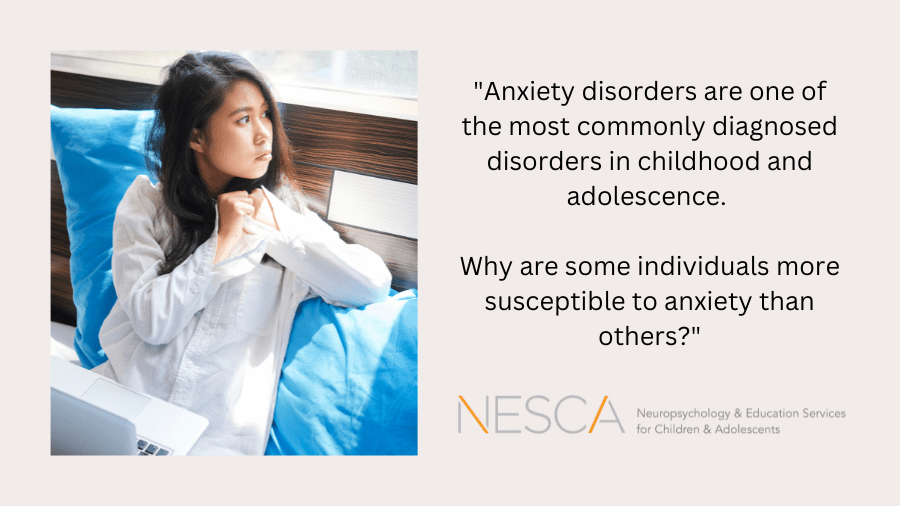
 By: Ferne Pinard, Ph.D.
By: Ferne Pinard, Ph.D.
NESCA Pediatric Neuropsychologist
Anxiety disorders are one of the most commonly diagnosed disorders in childhood and adolescence. According to the Centers for Disease Control and Prevention (CDC), 9.4% of children aged 3-17 years (approximately 5.8 million) were diagnosed with anxiety between 2016-2019. These numbers have increased significantly during the COVID-19 pandemic. Some studies estimate that the prevalence of child and adolescent anxiety disorders nearly doubled during the pandemic.
Why are some individuals more susceptible to anxiety than others? The development of anxiety and anxiety disorders during youth is not simple or straightforward but involves complex interactions among the following variables:
- Temperament: Children with the behavioral inhibition temperamental style described as timidity, shyness, and emotional restraint when with unfamiliar people and or in new places are more likely to develop anxiety disorders.
- Parent-child Attachment: Children who did not experience a trusting and secure parental bond, but received inconsistent responses from caregivers and are preoccupied with the caregiver’s emotional availability (Ambivalent attachment) are at increased risk for developing an anxiety disorder.
- Parental Anxiety: Children with anxious parents are at higher risk of developing an anxiety disorder. This relation is partly influenced by genetics. The risk of developing specific anxiety disorders has been associated with various genes. These can be passed to the child, thereby increasing their genetic vulnerability to anxiety disorders. However, parental behavior and practices are also important in understanding this link.
- Parenting Behavior/Practices: When parents model anxious, overcontrolling, or demanding behavior, their children are more reluctant to explore new situations and display more avoidance behaviors.
- Adversity: Trauma, negative/stressful life events as well as low socio-economic status are also risk factors for childhood anxiety. The more adverse life events an individual experiences in childhood, the greater the likelihood that they will develop an anxiety disorder. They also experience higher levels of anxiety.
- COVID-19: The combination of social isolation and lack of support networks increased anxiety among youth during the COVID-19 pandemic.
- Bullying: Being the victim or perpetrator of bulling is also associated with anxiety symptoms later on in life
- Externalizing Disorders: Adolescents with early externalizing disorders are at increased risk for later anxiety disorders. Attention Deficit/Hyperactivity Disorder (ADHD), in particular, is a significant risk factor.
- Sleep: Sleep disturbance often predicts the emergence of anxiety disorders.
- Cognition: Maladaptive cognitive responses (e.g., inability to tolerate distress, negative beliefs about uncertainty, avoidance of new/unfamiliar people/things, and repetitive negative thinking) are associated with impaired emotion regulation and a greater risk of developing anxiety disorders.
Supportive relationships with family and peers as well as problem-focused coping strategies can guard against anxiety disorders. Problem-focused coping refers to strategies that directly address the problem to minimize its effect.
Parents, caregivers, and other adults involved can also help by:
- being aware of the signs of anxiety
- being mindful of expectations set for children and teens
- encouraging participation in sports teams, clubs, community- or religious-based groups
- supporting a healthy lifestyle, including a nutritious diet, exercise, and adequate sleep
- providing access to support services
References:
Donovan, C. L., & Spence, S. H. (2000). Prevention of childhood anxiety disorders. Clinical psychology review, 20(4), 509-531.
Vallance, A., & Fernandez, V. (2016). Anxiety disorders in children and adolescents: Aetiology, diagnosis and treatment. BJPsych Advances, 22(5), 335-344. doi:10.1192/apt.bp.114.014183
Warner, E. N., & Strawn, J. R. (2023). Risk Factors for Pediatric Anxiety Disorders. Child and Adolescent Psychiatric Clinics. Published: February 26, 2023 DOI: https://doi.org/10.1016/j.chc.2022.10.001
About Pediatric Neuropsychologist Ferne Pinard, Ph.D. 
Dr. Pinard provides comprehensive evaluation services for children, adolescents, and young adults with learning disabilities, attention deficit/hyperactivity disorders (ADHD), and psychiatric disorders as well as complex medical histories and neurological conditions. She has expertise in assessing children and adolescents with childhood cancer as well as neuro-immunological disorders, including opsoclonus-myoclonus-ataxia syndrome (“dancing eyes syndrome”), central nervous system vasculitis, Hashimoto’s encephalopathy, lupus, auto-immune encephalitis, multiple sclerosis (MS), acute disseminated encephalomyelitis (ADEM), and acute transverse myelitis (ATM), and optic neuritis.
To book a neuropsychological evaluation with Dr. Pinard or another expert neuropsychologist at NESCA, complete NESCA’s online intake form.
Neuropsychology & Education Services for Children & Adolescents (NESCA) is a pediatric neuropsychology practice and integrative treatment center with offices in Newton and Plainville, Massachusetts; Londonderry, New Hampshire; and Coaching and Transition staff in greater Burlington, Vermont, serving clients from preschool through young adulthood and their families. For more information, please email info@nesca-newton.com or call 617-658-9800.

